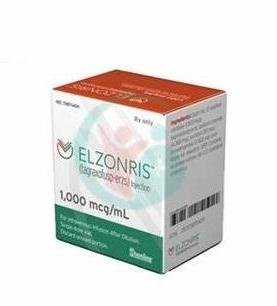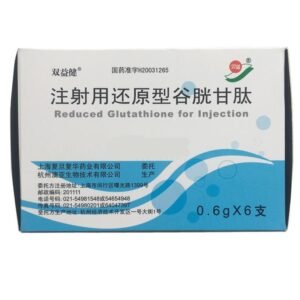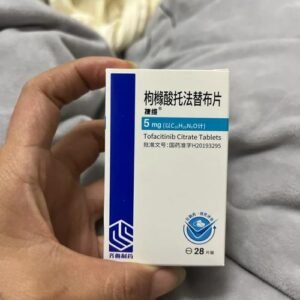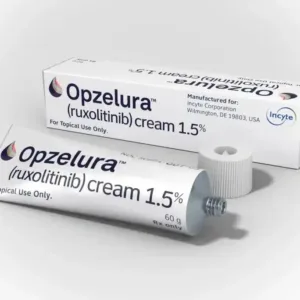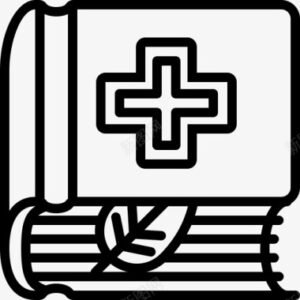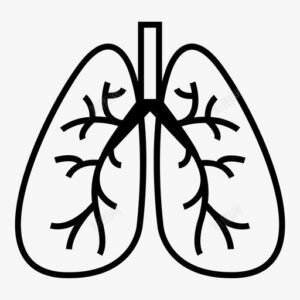Elzonris(tagraxofusp-erzs)
Elzonris indications
For the treatment of blastic plasmacytoid dendritic cell neoplasm (BPDCN) in children aged 2 years and older and in adult patients:
Treatment-naive patients
Previously treated patients
(Note: BPDCN is a rare and aggressive hematologic malignancy)
Elzonris specifications
Injection: 1,000 μg/1 mL (single-dose vial)
Elzonris mechanism of action
Antibody-drug conjugate (ADC) targeting CD123:
Targeting part: Interleukin-3 (IL-3) specifically binds to CD123 antigen on the surface of tumor cells
Cytotoxic part: Conjugated truncated diphtheria toxin causes tumor cell apoptosis
Unique mechanism: Selectively kills tumor cells that highly express CD123
Elzonris global approval status
U.S. FDA (approved on December 21, 2018):
The first BPDCM targeted therapeutic drug
Obtained orphan drug status and priority review
EU EMA (approved on January 7, 2021)
Elzonris usage and dosage
Standard dose:
12 μg/kg Intravenous infusion (each infusion time ≥15 minutes)
Dosing cycle: 1 cycle every 21 days, daily administration on days 1-5
Key management requirements:
Pretreatment medication: Administer 1 hour before infusion:
Corticosteroids (such as dexamethasone)
H1/H2 receptor antagonists
Antipyretic analgesics
Monitoring requirements:
Before treatment: test serum albumin, liver function, body weight
The first dose of each cycle: inpatient monitoring ≥24 hours
Subsequent infusions: outpatient monitoring ≥4 hours
Dose adjustment: Adverse reaction level treatment measures Capillary leak syndrome (CLS) Permanent discontinuation of drug Elevated liver enzymes (≥5 times ULN) Suspend medication until recovery
Elzonris adverse reactions
≥20% incidence (key research data):
Systemic reactions: fever (77%), peripheral edema (55%), fatigue (41%)
Digestive system: nausea (64%), vomiting (32%)
Laboratory abnormalities:
Hypoalbuminemia (83%)
Elevated liver enzymes (ALT 45%/AST 41%)
Black box warning:
Capillary leak syndrome (CLS):
Potentially life-threatening (manifested as hypotension, hypoalbuminemia, edema)
Weight needs to be monitored (increase ≥3% indicates risk)
Hepatotoxicity:
May progress to liver failure
Elzonris clinical research data
Key study STML-401-0114 (NCT02113982):
Patient type Number of cases ORR Median OS First-time patients 29 90% Not reached Experienced patients 15 67% 8.5 months
Survival data: First-time patients 24-month survival rate reaches 52%
Elzonris special population medication
Pediatric patients:
Safety of patients ≥2 years old is similar to that of adults
Data for patients <2 years old is missing
Pregnancy:
Animal studies show embryotoxicity (contraindicated during pregnancy)
Lactation:
Discontinue medication for ≥1 week after the end of lactation
Elzonris drug interactions
Hepatotoxic drugs (such as acetaminophen): increase the risk of liver damage
Immunosuppressants: may increase the risk of infection
Elzonris precautions
CLS monitoring:
Serum albumin needs to be ≥3.2 g/dL before treatment
Monitor body weight daily (sudden increase of ≥3% needs to be vigilant)
Infection prevention and control:
Prophylactic use of antiviral/antibacterial drugs (if necessary)
Infusion management:
Intravenous infusion only (subcutaneous/intramuscular injection is prohibited)
Dilution with 0.9% sodium chloride is required before infusion
Elzonris FAQs
Q: What should I do if chills occur after infusion?
A: Immediately suspend the infusion and give symptomatic treatment (such as diphenhydramine). The infusion can be resumed after the symptoms are relieved
Q: Can I get vaccinated during treatment?
A: Live vaccines (such as MMR vaccine) are prohibited, and the response to inactivated vaccines may be reduced
Q: How to judge the early symptoms of CLS?
A: Pay attention to sudden weight gain, lower limb edema or dyspnea
Q: Is routine prevention of CLS necessary?
A: There is currently no standard prevention program, and strict monitoring is the key
(Note: This manual integrates FDA/EMA approval information, please follow local regulations for specific use)
Appendix: Important safety tips
The first use must be carried out in a medical institution with rescue conditions
The patient's liver function and cardiovascular status must be assessed before prescription
Share:
Products
Our offers
Health Classification
Let us work together to protect precious health

